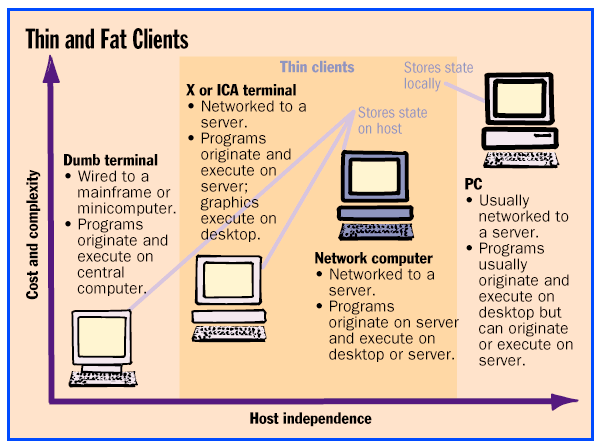| PCs are a pain in the wallet. At least that's what the
analysts say. At the center of the controversy over thin clients are some widely quoted — and frightening — studies on total cost of PC ownership: what it costs to manage, maintain, and replace PCs over the long haul. The Gartner Group, the most famous author of these studies, pegs the five-year cost of owning a PC with Windows 3.1 at $44,250. It's $38,900 for Windows 95 and $38,400 for Windows NT. Zona Research studied the five-year cost of 15 Windows PCs with an NT server and compared it to the cost of 15 Wyse Winterm clients with an NT/WinFrame server. The result: PCs, $217,663; thin clients, $94,368. Other studies have come up with different numbers, but they've arrived at the same conclusions: Considering all factors, thin clients beat PCs hands down. How do analysts arrive at those numbers? Are they reliable? What are the variables? While a detailed critique is beyond the scope of this article, it comes down to the following factors. • PCs cost more to buy than thin clients, even after improving servers and networks for thin clients. • PCs are more trouble prone, so they need more technical support. • PC users often try to solve technical problems themselves — which sometimes makes the problems worse, and always interferes with their real jobs. Users — not MIS professionals — provide about two-thirds of their own support. In fact, users refer only one problem out of 10 to a help desk. Their first recourse: Summon the nearest geek. "Pretty soon you've got four people hanging around the computer, trying to fix it," says Gartner Group analyst Bill Kerwin. The loss of productivity and extra problems these users cause eventually cost the company 50 percent more than professional support. • PCs are more difficult to use, so users require more instruction and training. • PCs allow users to install their own software, which frequently leads to mishaps. • PCs become obsolete faster; thus, businesses must replace them more often. Interestingly, one way that thin clients don't save money is by reducing MIS staff — a relief to managers who resist thin clients because of secret fears their department will be downsized. In fact, according to Kerwin, "Well-managed PC environments and network-computer environments might actually increase the demand for centralized IS services because they move tech support to where it belongs — and where it costs less in the long run." Thin clients are less troublesome to begin with, but when something does go wrong, it's usually on the server side — where users don't meddle. Greg Blatnik, an analyst for Zona Research, agrees, saying, "That eliminates a huge potential for headaches, problems, and administrative responsibilities, because the user doesn't have to act as his or her own system administrator." Still, businesses can dramatically cut the costs of owning PCs by tightening their maintenance and administration practices and by managing better. The Gartner Group estimates that thin clients are 30 percent to 40 percent less expensive to own than PCs in a typical corporate environment, but in a well-managed environment they're only 5 percent to 15 percent less expensive. That's why no analysts are predicting that thin clients will entirely replace PCs. But the Gartner Group estimates that thin clients will account for 20 percent to 30 percent of all desktop computer shipments by the year 2000. Thin and Fat Clients Thin clients fall in between. Copyright 1994-1998 BYTE |